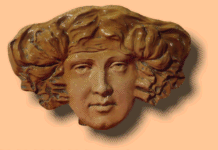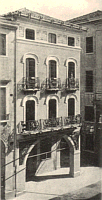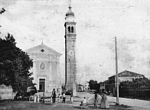 |
Some examples in Treviso |

 The changes in the artistic canons and the
devastation of the last world war notwithstanding, there are still some examples of the
decorations from the Guerra-Gregorj Kilns.
The changes in the artistic canons and the
devastation of the last world war notwithstanding, there are still some examples of the
decorations from the Guerra-Gregorj Kilns.
In the building which now accommodates the Telecom offices, in the Piazzetta dei Noli, a multicoloured tiled frieze can be admired, still in a perfect state of conservation and left miraculously intact even after the bombings of the city. The frieze extends from one side of the building to the other, representing feminine figures in drapes and flowered festoons.
In Piazza S.Leonardo the sign of the F. Bortolan Bakery still remains, in varnished tiles with decorations of wheat.
A few steps away, nearby this same plaza, there is a storefront, now taken over by a shop, completely covered with decorative panels, originally created for an old butcher shop.
 We can no longer admire the
succession of panels in multicoloured ceramic, created and realised by Piero Murani for
the Fabio-Sommariva Caffè, which was situated in the centre of Treviso a few steps away
from the Piazza dei Signori. The female images, semi-nudes, although mantled in grace,
were considered to be too shocking in the 1950's and were covered over by the owner at the
time. The current owners are most likely completely ignorant of this significant fact.
We can no longer admire the
succession of panels in multicoloured ceramic, created and realised by Piero Murani for
the Fabio-Sommariva Caffè, which was situated in the centre of Treviso a few steps away
from the Piazza dei Signori. The female images, semi-nudes, although mantled in grace,
were considered to be too shocking in the 1950's and were covered over by the owner at the
time. The current owners are most likely completely ignorant of this significant fact.
 A few kilometres from the city, at Lancenigo
of Villorba, the sun-dial designed by Mario Gregorj in ceramic tiles stands out on the
façade of the villa veneta 'Angarani delle Stelle'. The representation is inspired by an image of "The
Industry" by Veronese which is located in the Doge's Palace of Venice and has Latin
citations, "quam levis hora ruit, pueri dum Tempus habemus, eia ergo, aeternas rite
paremus opes…" suggested by the poet Clemente Rebora to Mrs Linda Saccomani whom she had asked them.
A few kilometres from the city, at Lancenigo
of Villorba, the sun-dial designed by Mario Gregorj in ceramic tiles stands out on the
façade of the villa veneta 'Angarani delle Stelle'. The representation is inspired by an image of "The
Industry" by Veronese which is located in the Doge's Palace of Venice and has Latin
citations, "quam levis hora ruit, pueri dum Tempus habemus, eia ergo, aeternas rite
paremus opes…" suggested by the poet Clemente Rebora to Mrs Linda Saccomani whom she had asked them.
On the façade of what is now Villa Manfrin, once Villa Margherita named after the English owner of the villa, Margherita Lichtenberg, there were once decorative panels in ceramic, representing saints and warriors, which were removed at the end of the 1930's. There is only one panel still intact, one which represents a warrior, presented and given an award at the Brussels Exhibition in 1910.
 Another example of excellent craftsmanship,
unfortunately destroyed in the 1960's, was represented by the decorations in Vincenzo
Gregorj's Casa ai Noli, where currently we find the building of the Banca Commericale
Italiana. Vincenzo Gregorj's only daughter, Gina, married the young Nando Salce, who was a
businessman and a man of great culture from Treviso and kept a collection of numerous
publicity posters, Italian as well as foreign, dating from the turn of the century until
the 1960's. This unusual and painstakingly made collection was then donated to the
Ministry for Public Education.
Another example of excellent craftsmanship,
unfortunately destroyed in the 1960's, was represented by the decorations in Vincenzo
Gregorj's Casa ai Noli, where currently we find the building of the Banca Commericale
Italiana. Vincenzo Gregorj's only daughter, Gina, married the young Nando Salce, who was a
businessman and a man of great culture from Treviso and kept a collection of numerous
publicity posters, Italian as well as foreign, dating from the turn of the century until
the 1960's. This unusual and painstakingly made collection was then donated to the
Ministry for Public Education.
 The works of decorative arts from the kilns are still numerous and
spread out in the province of Treviso. The religious pieces are found on the façades of
the churches (the parochial church of Saint Antonino with a Christ figure, the parochial
church of Canizzano with the figures of Christ and Saint Joseph, the parochial church at
Dosson, the church of Saint John on the cross). Many also are the pieces purely of a
decorative nature, such as the roses, ribbons and hands interlocked in friendship which
adorn the old Co-operative in Casier and in the recently restored minor villas in San
Donà di Piave and Castelfranco Veneto.
The works of decorative arts from the kilns are still numerous and
spread out in the province of Treviso. The religious pieces are found on the façades of
the churches (the parochial church of Saint Antonino with a Christ figure, the parochial
church of Canizzano with the figures of Christ and Saint Joseph, the parochial church at
Dosson, the church of Saint John on the cross). Many also are the pieces purely of a
decorative nature, such as the roses, ribbons and hands interlocked in friendship which
adorn the old Co-operative in Casier and in the recently restored minor villas in San
Donà di Piave and Castelfranco Veneto.
In the recent years, a greater attention has been paid to the recovery of the majolica decorations found in buildings to be restored, even those decoration with very simple workmanship. This bears witness to the greater consideration which is being given to the cultural heritage of the past.
 The concept of
Industrial Archaeology, which up until some decades ago was almost unknown in Italy
despite the illustrious examples of recovery done in the rest of Europe, in the United
States and in Latin America, has become more and more important. Even the Italian society
itself, which after World War II has been the protagonist of a dizzying economic
development, has begun to take into consideration cultural and sociological values. The
marks made by these works of the past, from those of the buildings no longer in use to
those simple archaeological finds even of very small dimensions are proof of previous
studies and knowledge of techniques and methods which today are almost unknown.
The concept of
Industrial Archaeology, which up until some decades ago was almost unknown in Italy
despite the illustrious examples of recovery done in the rest of Europe, in the United
States and in Latin America, has become more and more important. Even the Italian society
itself, which after World War II has been the protagonist of a dizzying economic
development, has begun to take into consideration cultural and sociological values. The
marks made by these works of the past, from those of the buildings no longer in use to
those simple archaeological finds even of very small dimensions are proof of previous
studies and knowledge of techniques and methods which today are almost unknown.
Currently there has been an enormous interest in these techniques subsequent to the publication of articles on this topic from the 1980's. We must cite an essay of great value, published in the Qui Touring journal, dated January 1980, titled "But that factory really is a work of art", by Lucia Bisi. It talks about the situation in our country and the testimonials of hard work from the past still in existence today. Even the Guerra-Gregorj Kilns was a subject of study both by amateurs and scholars as well as university institutions. Research has been done and graduation theses made by the University of Venice's architecture department and also the Accademia di Belle Arti in Venice. At the moment, other theses are being written up which have the aim of doing additional research, documentation and the formulation of project proposals on the Kilns.
|